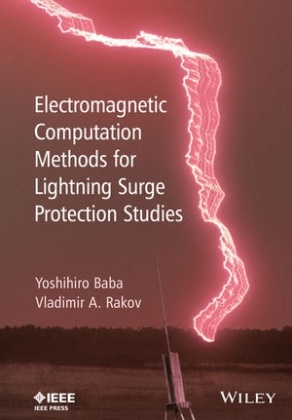Read more
Presents current research into electromagnetic computation theories with particular emphasis on Finite-Difference Time-Domain Method This book is the first to consolidate current research and to examine the theories of electromagnetic computation methods in relation to lightning surge protection.
List of contents
Preface xi
1 Introduction 1
1.1 Historical Overview of Lightning Electromagnetic-Field and Surge Computations 1
1.2 Overview of Existing Electromagnetic Computation Methods 2
1.2.1 Method of Moments 2
1.2.2 Partial-Element Equivalent-Circuit Method 4
1.2.3 Finite-Element Method 4
1.2.4 Transmission Line Modeling Method 4
1.2.5 Constrained Interpolation Profile Method 5
1.2.6 Finite-Difference Time Domain Method 6
1.3 Summary 7
References 7
2 Lightning 11
2.1 Introduction 11
2.2 Thundercloud 12
2.2.1 Formation of Thunderclouds 12
2.2.2 Mechanism of Cloud Electrification 14
2.3 Lightning Discharges 15
2.3.1 Categories of Lightning Discharges 15
2.3.2 Classification of Cloud-to-Ground Lightning Discharges 15
2.3.3 Downward Negative Lightning Discharges to Ground 16
2.3.4 Positive Lightning Discharges 23
2.3.5 Upward Lightning Discharges 23
2.3.6 Rocket-Triggered Lightning Discharges 25
2.4 Lightning Electromagnetic Fields 26
2.4.1 Measured Lightning Return-Stroke Electromagnetic Fields 26
2.4.2 Mathematical Expressions for Calculating Electric and Magnetic Fields 29
2.5 Lightning Surges 31
2.5.1 Surges Due to Direct Lightning Strike 31
2.5.2 Surges Induced by a Nearby Lightning Strike 32
2.5.3 Surges Coming from Grounding Due to Its Potential Rise 33
2.6 Lightning Surge Protection 34
2.6.1 Insulation Coordination 34
2.6.2 Protection against Direct Lightning Strikes 35
2.6.3 Back-Flashover Phenomena 37
2.6.4 Lightning Surge Protection Measures 38
2.7 Summary 40
References 41
3 The Finite-Difference Time Domain Method for Solving Maxwell's Equations 43
3.1 Introduction 43
3.2 Finite-Difference Expressions of Maxwell's Equations 44
3.2.1 3D Cartesian Coordinate System 44
3.2.2 2D Cylindrical Coordinate System 49
3.3 Subgridding Technique 51
3.4 Absorbing Boundary Conditions 55
3.5 Representation of Lumped Sources and Lumped Circuit Elements 57
3.5.1 Lumped Voltage Source 57
3.5.2 Lumped Current Source 57
3.5.3 Lumped Resistance 59
3.5.4 Lumped Inductance 59
3.5.5 Lumped Capacitance 60
3.6 Representation of Thin Wire 61
3.7 Representation of Lightning Return-Stroke Channel 63
3.7.1 Lightning Return-Stroke Channel 63
3.7.2 Excitations 66
3.8 Representation of Surge Arresters 67
3.9 Summary 69
References 70
4 Applications to Lightning Surge Protection Studies 73
4.1 Introduction 73
4.1.1 Overview 73
4.1.2 Lightning Electromagnetic Fields at Close and Far Distances 73
4.1.3 Lightning Surges on Overhead Power TL Conductors and Towers 75
4.1.4 Lightning Surges on Overhead Distribution and Telecommunication Lines 76
4.1.5 Lightning Electromagnetic Environment in Power Substations 77
4.1.6 Lightning Surges in Wind-Turbine-Generator Towers 77
4.1.7 Lightning Surges in Photovoltaic Arrays 78
4.1.8 Lightning Electromagnetic Environment in Electric Vehicles 78
4.1.9 Lightning Electromagnetic Environment in Airborne Vehicles 78
4.1.10 Lightning Surges and the Electromagnetic Environment in Buildings 79
4.1.11 Surges on Grounding Electrodes 79
4.2 Electromagnetic Fields at the Top of a Tall Building Associated with Nearby Lightning Return St
About the author
Professor Yoshihiro Baba, Associate Professor, Department of Electrical Engineering, Doshisha University, Kyoto, Japan
Professor Baba received his PhD from the University of Tokyo. He was Visiting Scholar at the Lightning Laboratory at the University of Florida, USA, and is currently Editor of the
IEEE Transactions on Power Delivery. His areas of interest include computational electromagnetics, electromagnetic compatibility and lightning protection.
Professor Vladimir A. Rakov, Department of Electrical and Computer Engineering, University of Florida, USA
Professor Rakov studied for his PhD at Tomsk University in Russia and has written extensively on the subject of lightning in numerous international journals and conference proceedings. He is A Fellow of the IEEE and a Fellow of the American Meteorological Society, amongst others, and his areas of interest cover lightning, lightning protection and atmospheric electricity.
Summary
Presents current research into electromagnetic computation theories with particular emphasis on Finite-Difference Time-Domain Method This book is the first to consolidate current research and to examine the theories of electromagnetic computation methods in relation to lightning surge protection.

